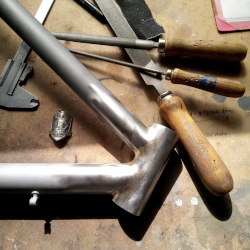Without going into too much technical detail and making speeches that the "common man" like me would not understand, I will try to explain as simply as possible putting myself in the shoes of an ordinary person who wants an answer as simple and comprehensive as possible.
The difference is enormous and substantially lies in the fact that the TIG melts the metals to be joined while the fillet brazed "pastes" them together with the addition of a metal alloy with a lower melting point.
In the latter method, there are two further options for conjunctions: frame with or without conjunctions.
Having said this, the question arises for the passionate cyclist: What is the best method among the three?
We analyze the different methods and draw conclusions. Nowadays, new steel alloys have exceptional breaking loads, allowing companies that produce pipes for cycling to create tubes with very thin walls, less than half a millimeter. Through appropriate heat treatments, these can withstand high stresses over a very long period of time (something unthinkable with aluminum or carbon frames).
Using the TIG method, as we mentioned, requires melting metals to join them, raising the temperature above 1450 °C. This partially alters the equilibrium of the brittle metal, and theoretically, breaks often occur just after the weld on all TIG welded frames, regardless of the material (aluminum, steel, titanium).

The fillet brazed method, being a "bonding" process, does not melt the metals to be joined, thus it does not significantly alter the balance, or at least it does so to a much lesser extent. This depends on the type of alloy/material used to join the pipes.
The alloys commonly used contain silver percentages ranging from 5% (the most common) up to 60% silver (the least used), with temperatures ranging from 850 °C to about 550 °C. The higher the silver percentage, the lower the "bonding" temperature, resulting in less stress on the tubes but more expense, as higher silver content is very costly.
Few artisans use alloys with 50-60% silver and advertise their method as "Silver Fillet Brazed".
I conclude with the pros and cons.
Frame TIG
Pros: ease of processing, clean appearance, lightweight, freedom of geometries. Cons: possible breakage of tubes with very thin walls.
Frame fillet brazed, without conjunctions
Pros: stiffer than TIG, does not alter the balance of the tubes, aesthetically pleasing (looks like a monocoque), freedom of geometries like TIG. Cons: slow processing, more expensive, a few tens of grams heavier.
Frame fillet brazed, with conjunctions
Pros: undisputed retro charm with worked and chromed conjunctions. Cons: slow processing, more expensive, limited in the choice of angles.








 Every frame I craft is tailored to your unique needs and preferences, ensuring a perfect fit and unmatched performance
Every frame I craft is tailored to your unique needs and preferences, ensuring a perfect fit and unmatched performance